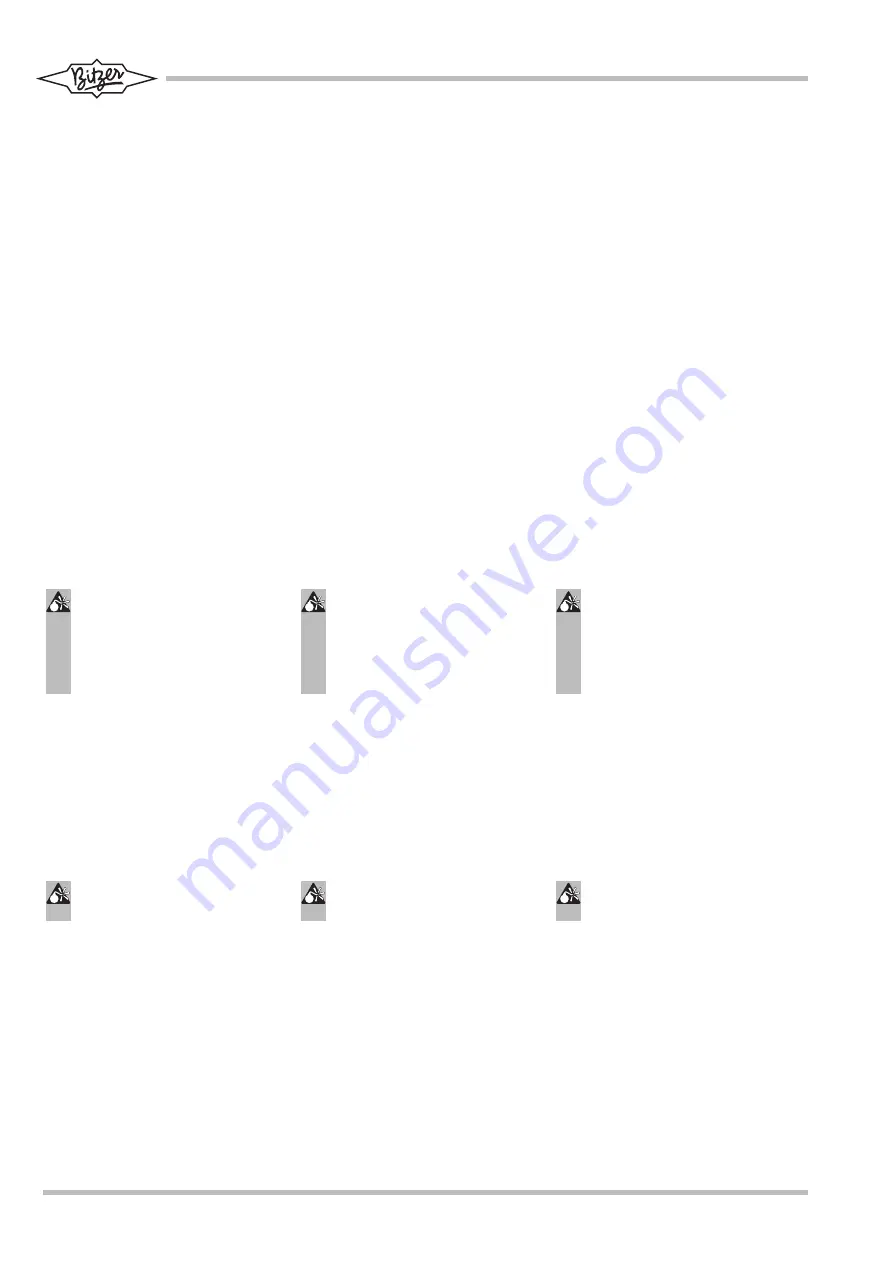
16
SB-500-2 i
Charge the oil directly into the oil sep-
arator and oil cooler before evacua-
tion. Remove plug from the oil sole-
noid valve. Keep the solenoid valve in
the oil injection line closed and open
the shut-off valves on the oil separator
/ oil cooler. The oil level in the oil sep-
arator should be within the sight glass
range. Additional oil for systems with
flooded evaporators should be mixed
directly with the refrigerant.
5.2 Strength pressure test
Evaluate the refrigerant circuit (as-
sembly) according to EN 378-2 (or
valid equivalent safety standards). The
compressor had been already tested
in the factory for strength pressure.
Therefore a tightness test (5.3) is suf-
ficient.
However, if the whole assembly is test-
ed for strength pressure:
Danger!
Test pressure shall not exceed
the maximum operating pres-
sures indicated on the name
plate!
If necessary leave the shut-off
valves closed!
5.3 Tightness test
Evaluate tightness of the entire refrig-
erant circuit (assembly) or parts of it –
according to EN 378-2 (or valid equiv-
alent safety standards) by using pre-
ferably an overpressure of dry nitro-
gen.
Danger!
Test pressures and safety refer-
ences see chapter 5.2.
5.4 Evacuation
Energize the oil heater.
Open all shut-off valves and solenoid
valves. Evacuate the entire system
including compressor using a vacuum
pump connected to the high and low
pressure sides.
When the pump is switched off a
"standing vacuum" of less than
1.5 mbar must be maintained.
If necessary repeat this procedure
several times.
Versare l'olio prima dell'eliminazione dell'a-
ria direttamente nel separatore d'olio e nel
raffreddatore dell'olio. Estrarre il connettore
dall'elettrovalvola. Tenere chiusa l'elettroval-
vola nel tubo d'iniezione olio ed aprire i
rubinetti del separatore / raffreddatore. Il
livello dell'olio nel separatore d'olio deve
essere all'interno del vetro spia. In caso di
sistemi con evaporatore allagato aggiunge-
re la quantità addizionale direttamente al
refrigerante.
5.2 Controllare la resistenza alla
pressione
Controllare il circuito frigorigeno (gruppo
costruttivo) a seconda della EN 378-2
(o norme di sicurezza equivalenti vigenti).
La resistenza alla pressione del compres-
sore è già stata controllata in officina.
Perciò è sufficiente controllare la tenuta
(5.3).
In ogni caso, nonostante viene controllata
la tenuta di tutto il gruppo costruttivo:
Pericolo!
La pressione di prova del compres-
sore non deve oltrepassare le pres-
sioni massime consentite indicate
sulla targhetta!
In caso di necessità tenere chiusi i
rubinetti!
5.3 Controllare la tenuta
Controllare tutto il circuito frigorigeno
(gruppo costruttivo) o parti dello stesso a
seconda della EN 378-2 (o norme di sicu-
rezza equivalenti vigenti). Allo scopo
generare la sovrappressione preferibil-
mente con azoto secco.
Pericolo!
Per pressioni di prova e indicazioni
di sicurezza vedi capitolo 5.2.
5.4 Fare il vuoto
Aprire i rubinetti e le elettrovalvole.
Eliminare l'aria da tutto il sistema com-
preso il compressore sul lato di aspirazio-
ne e su quello di alta pressione con l'aiu-
to di una pompa per vuoto.
Con alimentare la resistenza olio pompa
bloccata/arrestata deve essere raggiunto
un vuoto permanente inferiore a 1,5
mbar.
Se necessario ripetere l'operazione diver-
se volte.
Öl vor dem Evakuieren direkt in Ölab-
scheider und Ölkühler einfüllen. An-
schlussstecker vom Magnetventil
abziehen. Das Magnetventil in der
Öleinspritzleitung geschlossen halten
und Absperrventile von Abscheider /
Kühler öffnen. Der Füllstand im Ölab-
scheider sollte innerhalb des Schau-
glasbereiches liegen. Zusätzliche
Füllung bei Systemen mit überfluteten
Verdampfern dem Kältemittel direkt
beimischen.
5.2 Druckfestigkeit prüfen
Kältekreislauf (Baugruppe) entspre-
chend EN 378-2 prüfen (oder gültigen
äquivalenten Sicherheitsnormen). Der
Verdichter wurde bereits im Werk
einer Prüfung auf Druckfestigkeit
unterzogen. Eine Dichtheitsprüfung
(5.3) ist deshalb ausreichend.
Wenn dennoch die gesamte Baugrup-
pe auf Druckfestigkeit geprüft wird:
Gefahr!
Prüfdruck des Verdichters darf
die maximal zulässigen Drücke
nicht überschreiten, die auf dem
Typschild genannt sind!
Bei Bedarf Absperrventile
geschlossen halten!
5.3 Dichtheit prüfen
Kältekreislauf (Baugruppe) als Gan-
zes oder in Teilen auf Dichtheit prüfen
– entsprechend EN 378-2 (oder gülti-
gen äquivalenten Sicherheitsnormen).
Dazu vorzugsweise mit getrocknetem
Stickstoff einen Überdruck erzeugen.
Gefahr!
Prüfdrücke und Sicherheits-
hinweise siehe Kapitel 5.2.
5.4 Evakuieren
Ölheizung einschalten.
Vorhandene Absperr- und Magnet-
ventile öffnen. Das gesamte System
einschließlich Verdichter auf Saug-
und Hochdruckseite mit Vakuumpum-
pe evakuieren.
Bei abgesperrter Pumpenleistung
muss ein "stehendes Vakuum" kleiner
als 1,5 mbar erreicht werden.
Wenn nötig Vorgang mehrfach wieder-
holen.
Summary of Contents for OS.53 series
Page 27: ...27 SB 500 2 i ...













































